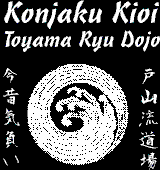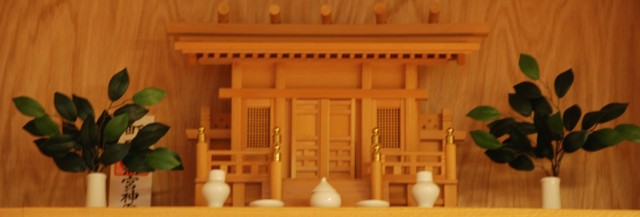 |
Toyama Ryu Batto Do Konjaku Kioi Dojo (Ancient and Modern Fighting Spirit Dojo) |
5980 66th St N Suite M St Petersburg FL 33709 Email: info@toyama-ryu.com Phone: 727-329-9679 |
|
Home
|
Bow In CeremonyThe bow-in and bow-out ceremonies are an essential part of the class in the Konjaku Kioi Toyama Ryu Dojo. They mark the beginning an end of training and help the student transition into the proper frame of mind for training. Unlike most iaido schools, our bow-in/out ceremony is done standing.
Placing Katana On The Sword Rack Before ClassKatana should be placed on the dojo sword rack before class with the tsuka (handle) on the left and the edge facing upward. The tsuka may be placed on the right in your home, but the katana need to be placed in a more respectful position at the dojo. Placing the tsuka on the right indicates the katana is ready to be grabbed and used quickly. The sageo should be tied to secure the blade in the saya and not interfere with the other katana (See “Tying the sageo”). Katana should be arranged in order of instructor / student seniority with the highest at the top of the rack. If multiple sword racks are used, the highest seniority is the sword rack farthest from the main dojo entrance. All katana should be placed on the sword rack before class begins. Dojo loaner katana have lower seniority than student katana. If a student is unsure of where to place their katana, they should pick a lower position. Not leaving space for you senior is a breach of etiquette. Set-Up For The Bow-In CeremonyKatana are gotten from the sword racks after warm-up exercises. Any time during class katana should be put up, and taken from, the sword rack in order of seniority from the highest to the lowest. The katana is grasped by the saya (scabbard) in the right hand with the thumb holding the tsuba (guard) in place. The ha (edge) should be up. The thumb should be off-center so that if the blade slipped out it would not cut the thumb. The sageo (saya cord) is grasped 2/3 down from the kurikata (knob on the saya where the sageo is tied) between the index and pointer fingers of the right hand. The instructor stands in front of the kamidana (Shinto Shrine signifying the heart of the dojo) and students line up facing them. Students should stand in order of seniority with the highest farthest from the dojo entrance. If multiple lines are needed the most senior students are in the front row. Student should line up with their senior and everyone should be evenly spaced. Call To AttentionThe instructor calls the students to attention with the command “KIOTSUKE”. The arms are held at the sides with the katana still in the right hand. The left hand should be held with fingers and thumb straight and together resting lightly on the thigh. Feet are angled slightly outward with the heels together. The knees are slightly bent and the back is straight. The head is held up with the shoulders down. Students should put themselves in the proper frame of mind to begin serious training. Bow To KamidanaThe instructor first turns to the kamidana (Shinto Shrine signifying the heart of the dojo) or an appropriate substitute. Following the instructor, katana are changed to a more respectful position. The right hand is brought forward and the left hand grasps the saya about six inches below the right hand. The right hand releases the saya but keeps the sageo between the fingers. The katana is tilted back with the left hand reversing the blade and the saya is again grasped with the right hand. The ha (edge) should be down and the tsuka (handle) should face forward. The left hand should be returned to the left side. The instructor says the command “SHINZEN NI – REI” and everyone takes a long deep bow towards the kamidana. This is the lowest and longest of the three bows. The back and neck should be kept straight. Do not bend your neck down or arch your back. The back should be about 45 degrees and the bow should last about 3 seconds. The instructor then leads the class in returning their katana to the normal position. The left hand grasps the saya about six inches below the right hand. The right hand releases the saya but keeps the sageo between the fingers. The katana is tilted forward with the left hand reversing the blade and the saya is again grasped with the right hand. The ha (edge) should be up and the tsuka (handle) should face to the rear. The left hand should be returned to the left side. The instructor turns to face the class once more. Bow To The Class / InstructorThe second bow is between the students and the instructor. The instructor calls for the bow saying ”OTOGAI NI – REI”. This bow should only be about 30 degrees and the eyes should remain looking forward. The back and neck should be kept straight. Do not bend your neck down or arch your back. The class should respond “ONEGAISHIMASU” during the bow. This is a request to be instructed. The bow should last about 2 seconds. Bow To Your KatanaThe third bow is to the katana. The instructor announces ”TORII”. The right hand is brought forward and up to the center and the ha should face backwards. The katana should rest on the left hand. The katana is rotated to horizontal position at eye level. The tsuba is held between the index and pointer fingers of the right hand. The saya kojiri (end cap) is held securely with the pointing finger of the left hand. The ha (edge) should face backwards. The instructor calls for the bow by announcing “REI”. This bow is the not a deep or long as the others. The bow is about 15 degrees and should last about 1 second. The back and neck should be kept straight. Do not bend your neck down or arch your back and keep your eyes looking forward. Putting Katana In ObiThe katana is returned to a vertical position with the right thumb grasping the tsuba keeping the katana from falling out of the saya. The sageo should still be between the first and second fingers of the right hand with the sageo should be split evenly into thirds. The left hand moves the saya kojiri to the left side of the obi. The katana goes between the first and second layer of the obi. The left thumb is used to open up the obi. The katana is slipped into and obi and goes above one of the front straps of the hakama. This is the strap that was tied in the back. The ha (edge) should be up. The sageo is looped up under the hakama straps on the right side. The loose end then goes through the first loop forming a second loop. The second loop is pulled to tighten the knot. It is important to face forward and keep alert when putting the katana and tying the sageo. The student should be mentally preparing for class and looking down would invite attack. |
Copyright © 2006 by Konjaku Kioi Toyama Ryu Dojo, All rights reserved.
Samurai Swords
Iaito (Practice Swords)
Shinken (Cutting Swords)
Wakizashi (Short Swords)
Tanto (Daggers)
Japanese Weapons
Maintenance
Uniforms
Sharpening
Sword Repair
Martial Arts
Dictionary Your Name in Japanese
Dojo Stories
Tatami Targets

